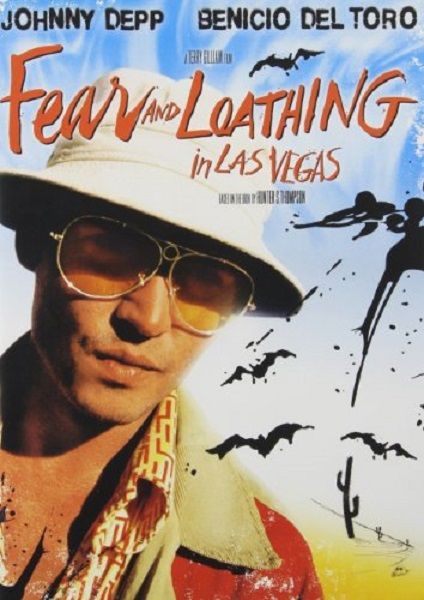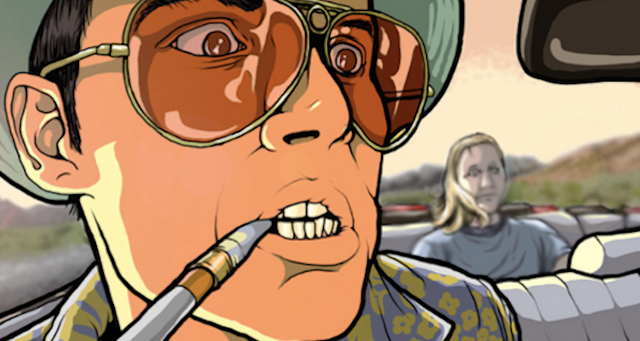"Fear and Loathing in Las Vegas " by Terry Gilliam - movie review
The 60s of the twentieth century, also known as the Swinging Sixties, remain in the history as a synonym for counterculture, accompanied by narcotic hunger, failed attempts at social reforms, blooms for world peace, obsessive conquest. In addition to hippie and psychedelic rock, the 1960s also give birth to the cultural icon Hunter Thompson, the voice of a generation whose longings are collapsing in the pursuit of the American Dream. "Fear and Loathing in Las Vegas " is based on a trip to Las Vegas, Nevada, which Thompson undertook with his attorney Oscar Ascot in March 1971 to reflect the annual Mint 400 contest. Thompson says that the mind-boggling journey to him has ended in a hotel room, with a 36-hour feverish description of the pocketbook survivors. The first manuscript of "Fear and Loathing in Las Vegas " is just this notebook. In November, Rolling Stone published the full text of the completed book in two parts, with illustrations by Ralph Steedman.

"Fear and Loathing in Las Vegas " is a phrase used by many writers, for the first time mentioned by Frederick Nietzsche in his short work Antichrist. In an interview with Rolling Stone magazine, Thompson says that "it came from my own sense of fear, and I thought it was an ideal description of the situation, even though I was accused of stealing from Nietzsche or Kafka or someone else. I just sounded like something to me. " In the Thompson interpretation fear is comic, and hatred is startling. Whatever the case, the phrase "Fear and Loathing in Las Vegas " is quickly becoming the cornerstone of American literature in the second half of the 20th century. The popularity of the novel briefly attracted the attention of Martin Scorsese and Oliver Stone, both of whom failed to film a movie, while the titles Jack Nicholson and Marlon Brando were planned for the main roles, but both were defined as " adults from the images they have to play. " Art Linson directed The Buffalo Roam, starring Bill Murray and Peter Boyle. The script is the amalgam of many of Thompson's stories, including fragments of "Fear and Loathing in Las Vegas ". Later, when Johnnie Depp prepares his transformation into Thompson (the author himself shaves Depp's head), Bill Murray advises him to play something fundamentally different as a next role, otherwise he risks being stuck in his career as a person who is complicated image. Oh, the irony! In 1989, Terry Gilliam received a script from Ralph Steedman, but he believed that in this form, "the script does not capture history correctly." Six years later, a revised text appeared in Gillian's hands. His 1998 release, starring Johnny Depp and Benicio del Toro, received mixed criticism, failed in the box office results, but became a cult classic, now commanded by masterpieces ("Brazil" and "12 Monkeys") by the director . The non-linear narrative gathers us with Raul Duke (Johnnie Depp) and his lawyer, Dr. Gonzo (Benicio del Toro), who are about to head to Nevada to reflect the aforementioned event. The preparation includes a Great Red Shark, whose night rack is equipped with a small galaxy of drugs, hallucinogens and opiates, ready to blur the boundaries of imagination and reality.
#
Johnny Depp and Benicio Del Toro
The focus is quickly shifted from the race to the unceasing experience of the two, and that's where the journalism phenomenon called gonzo that Hunter Thompson creates. Their work is interrupted by surreal visions in the lobby of the hotel, the demolition of a hotel room, close encounters with malicious anthropomorphic animals, as seen from the recent past. The culmination lies in the realization of the essence of the American Dream, namely the debilitating impact of overconsumption. Hunter Thompson has repeatedly said that drug use is intended to turn it into a mess, in the "face" of a generation of mutilated, failed seekers. The comfort of the surplus Thompson borrows from his beloved Fitzgerald ("The Great Gatsby") is not a solution to the problems. Although fun in its extreme, the consequences of it are devastating and ridiculous often degenerates into a tragedy. It's hard to imagine another director whose distinctive style would better fit that story. The distorted, inconvenient angles characteristic of Gilliam create the sense of subjectivity needed by the viewer to "connect" to the complex, unpleasant image of Duke. The scene in the bar, when they arrive in Las Vegas when the impact of the LSD card ingested finally takes precedence, fantastically presents the paranoia and claustrophobia that occur in the head of the protagonist. And the costumes in which the anthropomorphic reptiles are dressed are true to the familiar artistic style of the book, the spontaneous and curvy illustrations of Ralph Steedman. Unpredictable and unusual, "Fear and Loathing in Las Vegas " works as a prism for the psychic experience. The viewing of the film itself is intoxicating, thanks to the colorful cinematography and the blurry colors. The rhythm is frenetic, ideally representing the euphoria of the endorphinated brain, which can only turn for an instant at 180 degrees - in intense introspection or grow into nightmare despair. And instead of talking about the coherence of the story, let's make a smile smile. The so-called "wave speech" is probably the most significant passage in history, (Hunter Thompson has repeatedly recited it when he had to read excerpts). Shortly after the notorious moment with the bathtub, where Benio Del Toro's exclusive performance reaches its peak, under the sounds of the classic performance of Jefferson Airplane - Somebody to love, Raul Duke relaxes in front of the typewriter and immerses us in his memories. And in particular one night in 1965, the year of the acid wave in San Francisco, thanks to which it exposes the hippie movement. The documentary footage of the dancing, inspired, young and smiling faces, ready to change the world, vividly contrasts with the writer's condemnation. Nostalgia and reality mingle to crystallize in a plausible picture at a time past, unleashing a series of incessant changes. If I had to sum up Terry Gilliam's cult masterpiece with one sentence, it would sound like, "We have to stand out of chaos to show it in a fun light." So when we remember drunken stories, we have more fun than when we created them. Narcotic boldness of Raul and Gonzo brings their charm, however perverse it may be. And overcoming all expectations undoubtedly helps in perceiving the confusing construction of "Fear and Loathing in Las Vegas " The purpose of the film is not just to entertain, although it does not make it a minute, its meaning is in the futility of everything that is happening.
great movie review thanks for sharing...
You are welcome :)
One of the movies that shaped my Id...

:D
Love Fear and Loathing in Las Vegas. Terry Gilliam and Hunter S. Thompson just a great combination.
Yes, It is very difficult and rare to see a psychedelic experience depicted in a movie.
need to watch this movie again
I watch it every year :D
‘Clean your shorts, goddamn it, like a big boy. Go on!’
That scene was hilarious
Yes..... :D so many genius scenes it this movie...
This post has received gratitude of 12.30% from @appreciator courtesy of @godflesh!
The opening of that film is so strong.
And I dig the monologue about the receding wave: "..with the right kind of eyes you can almost see the high-water mark."
Thanks for the post.